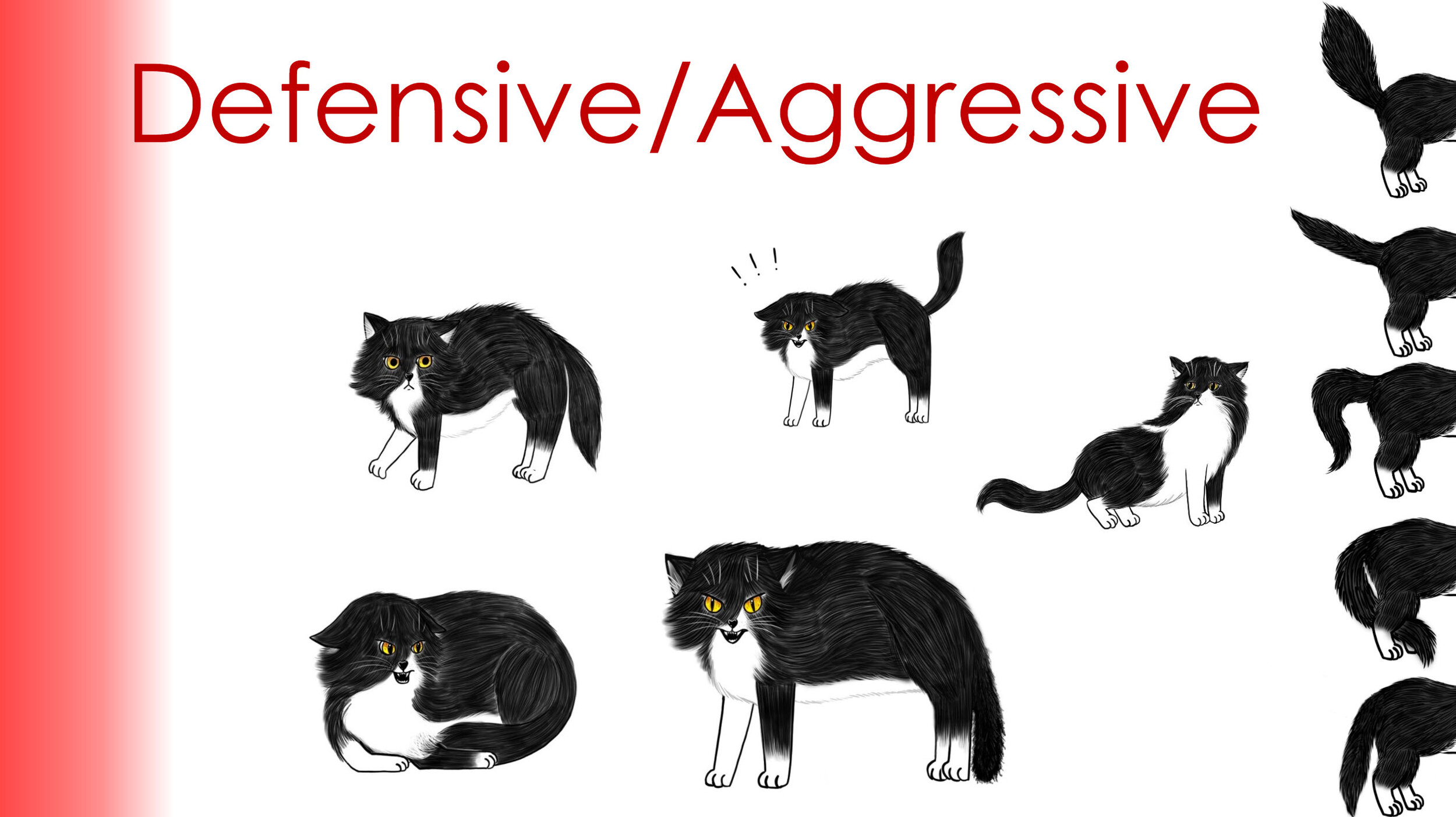How To Help An Aggressive Cat
If you’ve ever come face to face with an aggressive cat, you know just how terrifying those cute little things can be! There are many causes of aggression in cats and it’s up to us to pinpoint which type of aggression so we can begin to work on resolving the causes. Regardless of the type of aggression, let’s first look at how to de-escalate an attack.
Before, During, and After an Attack
To avoid an angry cat, watch for signs of aggression or irritation in your cat’s body language. Read my article on petting cats for more details
Stay calm - Your cat will react to your energy. If you become aggressive you risk riling them up even more
Slow blinking - make eye contact with the cat and very slowly blink at them. If they do not return the blink, immediately close your eyes into another slow blink while turning your head to the side, breaking eye contact, then open your eyes again. This is to show them you’re relaxed and not a threat. A cat who returns the blink is saying that they mean you no harm
If your cat latches onto you, try not to move and they will hopefully release you. If they do not release immediately, make loud noises to try to shock them. If that doesn’t work, carefully scruff and slowly get out from the cat’s grasp
Never physically retaliate or punish your cat in any way, it will only cause further damage to your relationship and their sense of security and may escalate the aggression
Remove yourself from the situation- If your cat is unable to relax with you present, it’s best to leave the room and allow them to cool down on their own with as little of a reaction as possible. If your cat gets a reaction every time they are aggressive, they will continue to do it. Back away slowly without making direct eye contact and use that slow blink!
Types of aggression
Petting Aggression
Petting your cat in a way they don’t like or for too long may cause them to become overstimulated and aggressive.
A cat who is becoming overstimulated will often show some very clear body language to let you know you should back off and let them cool down
Some examples of body language exhibited by a worried or overstimulated cat
Twitching or wagging tail - A relaxed cat will sometimes slowly wave the tip of their tail back and forth, but if that wave turns to a fast swishing or if it goes into a full wag, you better back off!
Skin Twitching - Let’s just say that twitching of any kind is a bad thing. Cats twitch their back skin when they are nervous or irritated
Ears turning back - Unless your cat just heard an interesting sound behind them, this will usually indicate they are about to pet you back, except with sharp little blades instead of soft peets
Quickly turning their head towards your hand - If this happens it’s a 50/50 chance they are going to lick your hand to thank you or bite your finger off. If there are no other signs of overstimulation and your cat is not known for biting, I wouldn’t worry. I guess if your finger is super important to you, maybe worry a little
Keeping your cat busy with regular, interactive play is the best way to relieve some of that excess energy and lower the chances of them becoming overstimulated. If your cat is frequently overstimulated or is anxious in general, they may need a little extra help remaining calm, such as a thunder shirt or some medication from your vet
Play Aggression
This type of aggression is often something that started when the cat was very young. Some folks get a little too hands-on when playing with their kittens, training them to bite and claw. The problem comes later when the cat is fully grown and those nips and swats are no longer cute!
Again, keeping your cat busy with regular, interactive play is the best way to work out this type of aggression. Remember never to play rough with your cat and always use toys instead of your hands. Reward proper play with lots of love and treats and this problem will eventually go away
Redirected Aggression
This type of aggression occurs when a cat becomes upset or overstimulated by something and is unable to directly attack the source of their frustration. This can be a loud noise, an outside animal, or even another pet or human inside the home. Sometimes the aggression may be redirected to the human, especially in the case of two cats who are separated and do not get along.
To prevent redirected aggression, you’ll need to remove the source of the excitement - use deterrents to keep any outside animals at bay and work on relationships within the home through regular play sessions and lots of equal love and attention to all of your cats. Adding more vertical territory never hurts! It will make your cats feel more safe and secure in their environment and less likely to be easily frightened
Examples of body language exhibited by a defensive or aggressive cat
Pain-induced Aggression
This one is pretty self-explanatory but it can be the hardest to diagnose since cats are so good at hiding pain! Cats in pain will often become aggressive when touched in the area that is hurting them, though some may just seem grumpy in general. Pain can come from a lot of sources, but the most common are dental issues and osteoarthritis. If your cat has suddenly started acting aggressive for no apparent reason, it’s time to have them checked at the vet just in case
Fear Aggression
When a cat is frightened enough, their fight or flight may be activated, causing them to lose control of themselves while they react with their brain’s preferred method of defense. A cat who typically fights when afraid may become extremely aggressive when frightened and may even lunge at you to attack.
Cats who are fearful will often display dilated pupils, flattened ears, and a tail that is tucked under their body or against their side. They may turn sideways in an attempt to leave or they may face the threat head-on and become even more aggressive, attempting to frighten the threat away
The best way to deal with fear aggression is to disengage completely. Do not retreat or approach and do not try to calm the cat down. Merely ignore the cat and avoid eye contact (remember to slow blink) until they back away and calm down.
Territorial Aggression
Cats are extremely territorial creatures and some may defend their territories fiercely from newcomers, feline or otherwise. Most often, these issues arise when a new pet is not properly introduced to the resident cats. To introduce to cats, you’ll need to perform a slow introduction, taking care to avoid any sort of conflict or negative interactions while building trust through shared positive experiences. This is a topic for another article altogether, but it’s also a process that’s unique to every cat and every situation. If you need help introducing a cat, why not schedule a consultation with me!
Non-recognition Aggression
A spin-off of territorial aggression, non-recognition aggression occurs when a cat leaves the home and comes back with an unfamiliar scent. This often occurs after vet visits or especially when staying at a hospital. Since cats heavily rely upon scent to identify their friends, they may be confused as to why this cat looks so much like their friend and react out of fear or territorial defense.
If this happens to you, temporarily separate the cat who is being attacked and wipe them down with items from the home that have their familiar scent on them, like bedding and toys
Occasionally, a full reintroduction needs to be done, in which case you may wish to contact a professional for help, like me, I’m that professional
Maternal Aggression
Cats who have given birth may become aggressive towards other animals or humans in an effort to protect their kittens. Just make sure the queen has a nice, quiet place to feel safe and secure. Don’t bother her unless necessary and do not try to touch the queen or her kittens if she becomes aggressive.
Some mother cats may become aggressive towards their own kittens, either because they do not wish to be mothers or because they are trying to push older kittens out of the area so they can make room for their next litter. As with other forms of aggression between cats, temporary separation and reintroduction may be in order if the kittens are sticking around
Intact-cat Aggression
This type of aggression occurs in cats who have not been neutered and includes maternal aggression. Intact cats are prone to highly aggressive and territorial behavior. Step one of any behavioral issue is to neuter your cat!
All cats and situations are unique, so if these tips don’t work for you or if you have any other cat behavioral or wellness concerns, I’d love to help you! Please contact me or book an appointment for personalized guidance and support
Have a story you’d like to share, questions about this article, or a completely different behavioral issue that I haven’t addressed? Let me know in the comments!


